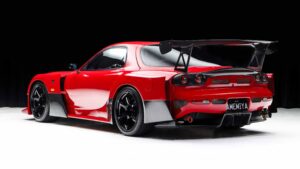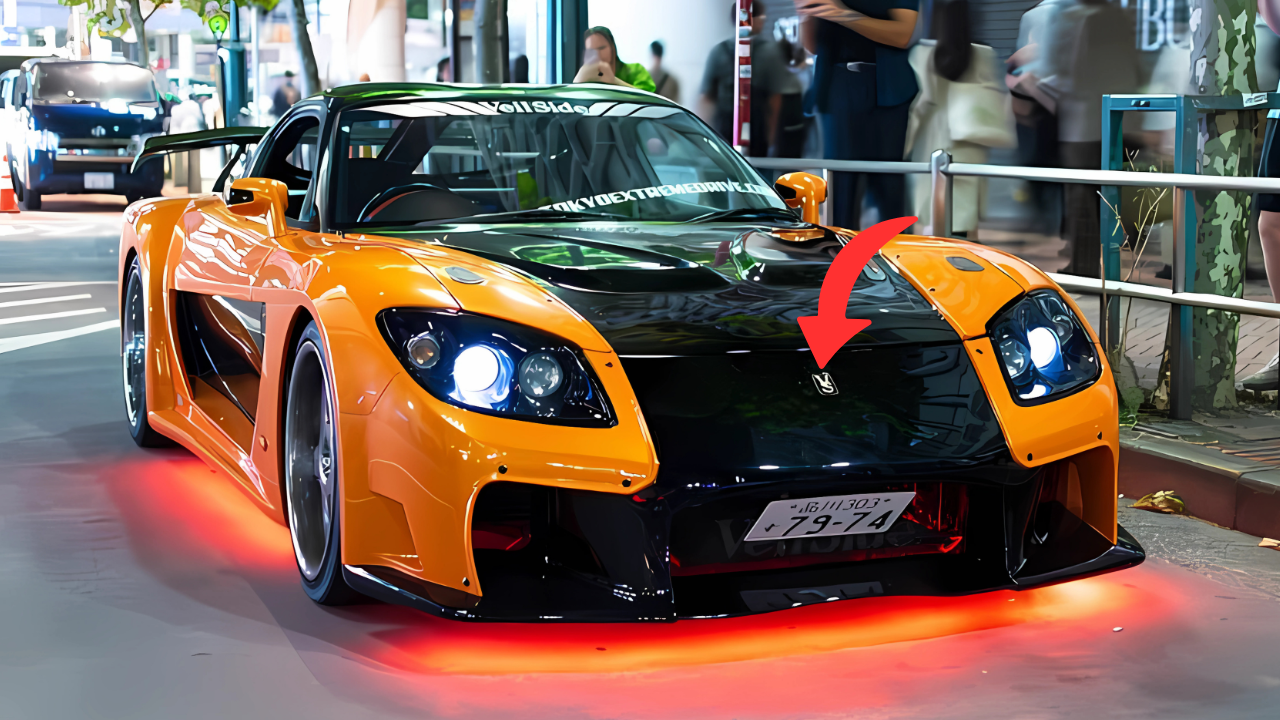For decades, Mazda enthusiasts have yearned for the return of the legendary RX-7, a car that defined an era of high-revving, rotary-powered performance. The RX-7, with its sleek design and unique Wankel engine, became an icon in the automotive world, blending Japanese engineering precision with a spirited driving experience. Now, Mazda is poised to reignite that passion with a new sports car inspired by the RX-7, potentially based on the stunning Iconic SP concept unveiled at the Japan Mobility Show in 2023. Recent reports suggest this eagerly anticipated model could hit the streets as early as 2026, bringing with it a modernized rotary engine and a hybrid powertrain that promises to blend tradition with cutting-edge technology. Here’s everything we know about Mazda’s bold new venture, its significance, and what it means for the future of performance cars.
A Legacy of Rotary Excellence
Mazda’s love affair with the rotary engine began in the 1960s when it licensed the Wankel design from NSU. The company’s first rotary-powered car, the Cosmo Sport, debuted in 1967, setting the stage for a lineage of performance vehicles that would include the RX-2, RX-3, RX-7, and RX-8. The RX-7, introduced in 1978, became the pinnacle of Mazda’s rotary legacy, with over 800,000 units produced across three generations (FB, FC, and FD) until its discontinuation in 2002. Its lightweight chassis, rear-wheel-drive layout, and high-revving rotary engine made it a favorite among enthusiasts and a staple in motorsport, including a cult following in drifting culture and pop culture appearances like The Fast and the Furious: Tokyo Drift.

The RX-7’s successor, the RX-8, carried the rotary torch until 2012 but faced criticism for reliability issues and fuel inefficiency, which led to its demise amid tightening emissions regulations. Since then, Mazda fans have clamored for a revival, and the company has teased the possibility with various concepts. The 2023 Iconic SP concept, with its sleek design and innovative powertrain, has brought those hopes closer to reality than ever before.
The Iconic SP Concept: A Glimpse of the Future
Unveiled at the Japan Mobility Show in 2023, the Mazda Iconic SP concept captured the imagination of car enthusiasts worldwide. Measuring 4,180 mm in length, it slots between the compact MX-5 Miata and the classic FD RX-7, offering a balanced footprint for a modern sports car. Its design is a love letter to Mazda’s heritage, featuring sculpted curves, slim LED headlights, an illuminated Mazda emblem, and a nod to the RX-7’s iconic pop-up headlights through a retractable LED assembly. The rear boasts a wide stance, circular taillights, and a full glass hatch, evoking the spirit of the FD generation while embracing contemporary aesthetics.
Under the hood, the Iconic SP introduces a twin-rotor rotary engine paired with an electric motor in a range-extender hybrid configuration, delivering approximately 365 horsepower. This setup, similar to the MX-30 E-Skyactiv R-EV, uses the rotary engine as a generator to charge a battery that powers electric motors, ensuring efficiency while maintaining the high-revving character Mazda’s rotary engines are known for. Additionally, Mazda is exploring a variant where the rotary engine directly drives the wheels, a nod to purists who crave the traditional RX-7 experience.
Mazda’s Chief Technical Officer, Ryuichi Umeshita, has described the Iconic SP as a “good successor for RX-7,” signaling strong intent to bring it to production. Mazda President and CEO Masahiro Moro has echoed this enthusiasm, emphasizing the rotary engine’s importance to the brand’s identity. However, the final name—whether RX-7, RX-9, or something new—remains unconfirmed, with Umeshita ruling out a return to the “Cosmo” moniker.
A New Rotary Engine for a New Era
The heart of the RX-7 successor is its next-generation rotary engine, which Mazda claims is “almost technically complete” and set to meet stringent emissions standards, including those in the U.S. market. This is a significant milestone, as the rotary engine’s historical drawbacks—poor fuel economy and high emissions—had previously sidelined it. The MX-30 marked the rotary’s return in 2023 as a range-extender in select markets, but its absence in the U.S. due to emissions issues highlighted the challenge. Mazda’s engineering team, comprised of veterans from the RX-7 and RX-8 eras, has reportedly overcome these hurdles, delivering a more efficient and powerful rotary engine for the Iconic SP.
The hybrid powertrain is a strategic move to balance performance with environmental considerations. By using the rotary engine as a range-extender, Mazda reduces reliance on large batteries, keeping the car lightweight—targeting around 1,450 kg (3,197 lbs)—and less dependent on EV charging infrastructure. This approach aligns with Mazda’s vision of sustainable performance, appealing to both enthusiasts and regulators. The potential for a direct-drive rotary variant adds further excitement, promising a driving experience reminiscent of the RX-7’s high-revving glory.
Positioning in Mazda’s Lineup
Unlike earlier speculation that the Iconic SP might replace the MX-5 Miata, Mazda has confirmed that the new sports car will sit above the Miata in its lineup, complementing rather than competing with it. The MX-5, now in its fourth generation (ND), remains Mazda’s affordable, lightweight roadster, with a fifth-generation model in development featuring a new Skyactiv-Z 2.5L four-cylinder engine for improved performance and efficiency. The RX-7 successor, positioned as a premium, low-volume model, will target enthusiasts seeking a more powerful and refined sports car experience.
This dual-sportscar strategy is a bold move for Mazda, a relatively small automaker. The company’s recent financial success, driven by crossover SUVs like the CX-60, CX-70, CX-80, and CX-90, has provided the resources to pursue passion projects like the RX-7 revival. However, Mazda must still build a viable business case, navigating challenges like U.S. tariffs and production costs. A potential partnership with Toyota, which has collaborated with Mazda on platforms and powertrains, could streamline development. Reports suggest Toyota’s next-generation GR Supra, moving away from its BMW Z4 roots, might share a rear-wheel-drive architecture with Mazda’s new sports car, reducing costs and enhancing feasibility.
Performance and Driving Dynamics
While full specifications are yet to be confirmed, the Iconic SP’s projected 365 horsepower places it in a competitive segment alongside the Toyota GR Supra, Nissan Z, and Porsche 718 Cayman. Early reports from pre-release events suggest the RX-7 successor will offer exceptional handling, with cornering grip approaching 1.0g and precise throttle and brake response. The low center of gravity, a hallmark of rotary engines due to their compact size, will enhance agility, making it a worthy successor to the FD RX-7’s balanced chassis.
The hybrid powertrain promises a blend of electric torque and rotary smoothness, delivering a unique driving experience. For purists, the potential direct-drive rotary variant could revive the high-revving thrill of the 13B engine, which powered the FD RX-7 to fame. Mazda’s commitment to a rear-wheel-drive layout and a possible six-speed manual transmission ensures the car stays true to its enthusiast roots.
Pricing and Market Positioning
Pricing for the RX-7 successor remains speculative, but estimates suggest a starting price above $50,000, potentially reaching $60,000 or more for higher trims like a hypothetical Spirit R variant, which could feature carbon fiber accents, Brembo brakes, and a limited-slip differential. This positions it between the Toyota GR Supra and the Porsche 718 Cayman, offering a premium yet attainable option for sports car enthusiasts. The low-volume production strategy will likely make it a collector’s item, appealing to Mazda loyalists and JDM fans.
|
Feature |
Mazda Iconic SP (RX-7 Successor) |
Mazda MX-5 Miata (ND) |
Toyota GR Supra |
Porsche 718 Cayman |
|---|---|---|---|---|
|
Powertrain |
Hybrid (Rotary + Electric, ~365 hp) |
2.0L 4-cylinder (~181 hp) |
3.0L Turbo 6-cylinder (~382 hp) |
2.0L Turbo 4-cylinder (~300 hp) |
|
Drive Layout |
Rear-Wheel Drive |
Rear-Wheel Drive |
Rear-Wheel Drive |
Rear-Wheel Drive |
|
Weight (Approx.) |
1,450 kg (3,197 lbs) |
1,050 kg (2,315 lbs) |
1,530 kg (3,373 lbs) |
1,365 kg (3,009 lbs) |
|
Estimated Price (USD) |
$50,000–$60,000+ | $30,000–$40,000 | $45,000–$55,000 | $65,000–$80,000 |
|
Launch Timeline |
2026 (Projected) |
2028 (Next-Gen) |
2025 (Current) |
2025 (Current) |
|
Transmission |
Auto (Possible Manual) |
6-Speed Manual/Auto |
8-Speed Auto |
6-Speed Manual/PDK |
Challenges and Expectations
Bringing the Iconic SP to production is not without challenges. Mazda must balance the costs of developing a low-volume sports car with the need to meet global emissions standards. The U.S. market, a key target, requires stringent compliance, which Mazda’s new rotary engine reportedly achieves. Additionally, the partnership with Toyota could be a double-edged sword—while it reduces costs, it risks diluting the RX-7’s unique identity if the platform is too closely tied to the GR Supra.
Enthusiast expectations are sky-high, given the RX-7’s legendary status. Mazda must deliver a car that honors its heritage while embracing modern demands for efficiency and technology. The hybrid powertrain, while innovative, may disappoint purists hoping for a pure rotary experience, though the direct-drive variant could address this. The design, inspired by the Iconic SP, must also translate from concept to production without losing its allure.
The Broader Impact
The RX-7 successor represents more than just a new model; it’s a statement of Mazda’s commitment to its performance heritage in an era dominated by EVs and crossovers. By reviving the rotary engine, Mazda is doubling down on its unique identity, setting itself apart from competitors. The car’s potential success could inspire other automakers to pursue passion projects, keeping the spirit of affordable, driver-focused sports cars alive.
For enthusiasts, the RX-7 successor is a beacon of hope. It promises to combine the soul of the FD RX-7—lightweight, agile, and exhilarating—with modern efficiency and refinement. Its coexistence with the MX-5 signals Mazda’s ambition to cater to diverse performance audiences, from budget-conscious Miata fans to those seeking a premium rotary experience.
Looking Forward
Mazda’s RX-7-inspired sports car, likely based on the Iconic SP concept, is shaping up to be a game-changer. With a next-generation rotary engine, hybrid powertrain, and a design that pays homage to its predecessor, it could redefine what a modern sports car can be. Expected to debut as early as 2026, it will sit alongside the MX-5 Miata, offering enthusiasts two distinct flavors of Mazda’s performance ethos. While challenges remain, Mazda’s commitment to the rotary engine and its partnership with Toyota position this project for success. For fans of the RX-7 and JDM culture, the wait is almost over—and the future looks thrilling.

